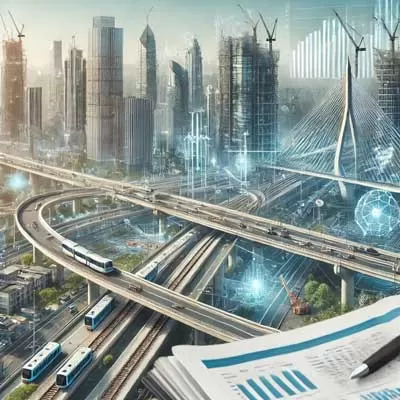The Union Budget 2025-26, unveiled by the Hon’ble Finance Minister, embodies a clear and ambitious vision, recognizing the pivotal role of investment in the economy as a key driver for national advancement. In alignment with this vision, the government has escalated the capital expenditure allocation for the infrastructure sector to an impressive Rs 11.21 lakh crore, marking a significant increase from previous years.
Reflecting on the past, the Economic Survey of the preceding year underscored the government's dominant investment in infrastructure, which substantially exceeds private sector contributions, with the latter accounting for less than one-third of the government's investment. This disparity is primarily due to investors' preference for conventional borrowing to meet substantial funding requirements. The latest Economic Survey has identified an imbalance in the bond market, where high-credit-rated bonds (AAA and AA) constitute over 85 percent of total issuances, leaving lower-rated entities reliant on conventional lending sources.
However, the feasibility of obtaining finance under standard lending conditions is challenging, and high-interest rates further complicate financing efforts. The proposal to enable the National Bank for Financing Infrastructure and Development (NaBFID) to establish a Partial Credit Enhancement Facility (PCEF) for corporate bonds is expected to bolster infrastructure project financing. The successful implementation of such a PCEF would require support from the Reserve Bank of India.
The previous National Monetisation Pipeline aimed to monetize INR 6 lakh crores of core assets by March 2025. Building on this, the current budget introduces an ambitious Asset Monetization Plan (AMP), targeting the monetization of Rs 10 lakh crore. With the expansion of public infrastructure in recent years, the government could consider monetizing key highways, mining, power, and metro assets to generate capital for new projects over a 5-year timeline under the new AMP. This strategic initiative is anticipated to provide the necessary funding to support viability gap funding and foster a conducive environment for private sector participation and investment, thereby catalysing further development and modernization of India's infrastructure.
To bridge the significant gap and promote Public-Private Partnerships (PPPs), the government has directed infrastructure-related ministries to develop a 3-year pipeline of projects suitable for PPP implementation. States are also encouraged to prepare PPP proposals and seek support from the India Infrastructure Project Development Fund. The establishment of an Urban Challenge Fund of INR 1 lakh crore, which will finance up to 25 per cent of the cost of bankable projects (including PPP projects), is expected to attract Rs 4 lakh crore of investments for the transformation of cities into dynamic growth hubs, enhancing infrastructure and urban living conditions. The initiative to overhaul existing Bilateral Investment Treaties will help create an investor-friendly environment and enhance private sector participation.
In an effort to attract foreign capital, the government has extended the investment timelines for sovereign wealth funds and pension funds in infrastructure projects by an additional 5 years for future tax exemptions.
The budget continues to build on the theme of inclusive economic development and improved connectivity with the UDAN - Regional Connectivity Scheme, which aims to revolutionize air travel by adding 120 new destinations and targeting 4 crore passengers over the next decade. The Purvodaya vision is further advanced, with plans for new and expanded airports in Bihar to enhance connectivity in the eastern region.
On the maritime front, the budget recognizes the need for a robust supply chain system and dedicated transportation vessels. It introduces a revamped Shipbuilding Financial Assistance Policy and a Shipbreaking Credit Note Policy to support ship recyclers. The establishment of the Maritime Development Fund with Rs 25,000 crore is a strategic move to encourage private sector participation and expand India’s maritime ecosystem. To further establish the International Financial Services Center (IFSC) as a premier global destination for ship leasing activities, the Government of India has introduced a series of tax incentives specifically designed for ship leasing units operating within the IFSC. These incentives include a complete tax exemption on the sale of shares and dividends for ship leasing units, a benefit that was previously exclusive to aircraft leasing units situated in the IFSC.
In addition, the government has extended the sunset clause for the commencement of operations in the IFSC to 31st March 2030, ensuring that entities in the maritime sector can avail themselves of various tax concessions for an extended period. This strategic move is aimed at bolstering India's position in the international maritime industry, fostering domestic engagement in coastal shipping, and supporting the nation's self-reliant initiative, Atmanirbhar Bharat.
Moreover, the recent expansion of the tonnage tax regime to encompass Inland Vessels as qualifying ships is a testament to the government's commitment to revitalizing the coastal shipping sector. This expansion is anticipated to provide a significant boost to the industry, aligning with the broader vision of enhancing India's maritime infrastructure and services.
Furthermore, the launch of a National Framework for Global Capability Centres, coupled with efforts to promote tourism with support from states and the private sector, is expected to boost the nation's GDP and drive job creation, with a focus on equipping the youth with necessary skills. The budget proposals collectively embody the 'India First' ethos, aiming to attract private sector investment, accelerate growth, and create a skilled workforce, thereby steering the nation towards a prosperous and self-reliant future.
It is evident from various policy announcements and tax incentives that the central government’s commitment to infrastructure development is poised to continue unabated beyond the sunset of the National Infrastructure Pipeline in March 2025. In fact, the next 5 years are expected to see an even more vigorous role in this sector. Stakeholders must actively engage with these opportunities, leverage the supportive policy environment, and contribute to building a resilient, sustainable, and inclusive infrastructure that will propel India towards achieving its vision of Viksit Bharat @2047.
[This is an authored article. Authors:Neetu Vinayek (Partner and Tax Leader – Infrastructure, EY LLP) and Jasdeep Sahni (Director, EY LLP). Supported by:Shashank Jain (Senior Manager, EY LLP), Kajal Bhanushali (Consultant, EY LLP)]





















